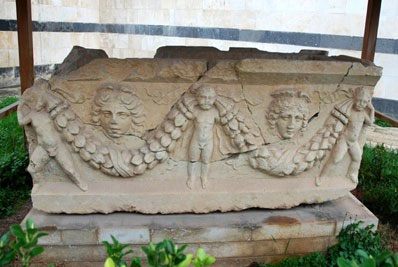Archaeological exhibited articles tell stories for hundreds of years of various civilizations that came to power and influence over the central region of Syria. Hama National Museum is filled with the most tremendous group of archaeological sarcophagus which is the most important contents of museums whole world, according to the classifications of archaeologists.
The National Museum contains unique and wide collection of sarcophagus that found at different archaeological sites of the city, including the rare in the world. The museum singled out a special hall to view these discoveries that divided into four forms: pottery, stone, wood and tin coffins.
Head of the Department of Hama Antiquities, Abdulkader Farzat, said that succession of civilizations on the central region was a key factor in spreading the cultures, philosophies and beliefs that differ from culture to culture and it is reflected through the “cultural and ideological symbols left behind these ruins including cemeteries and sarcophagus, which paves the way for understanding the peoples old ideas about life and death, customs and traditions.”
 “The main contents of the National Museum in Hama are wooden and stone tombs saved with glass boxes in order to protect them from corrosion as a result of temperature change of humidity or temperature, pointing to ingenuity in design and engineering which demonstrates the sculptor’s skill,” Mr. Firzat said.
“The main contents of the National Museum in Hama are wooden and stone tombs saved with glass boxes in order to protect them from corrosion as a result of temperature change of humidity or temperature, pointing to ingenuity in design and engineering which demonstrates the sculptor’s skill,” Mr. Firzat said.
A coffin, with a height of 120 cm rectangular shape, hollow inside and designed of beech, was found in the cemetery dates back to the Roman era, where analysis carbon carried indicates that it was made in the year 20 AD. Mr.Farzat noted to the presence of inscriptions in one of the sides of this coffin and an embossed sculpture in the that represent two winged gods.
He added that in the opposite side there are two sculptures represent two embossed lions with two opposite faces separated by a head of an ox. The scene shows strength and greatness. The ox in Romanian culture represents force while the lion represents greatness, pointing out that on the front of the coffin, a man’s face was engraved putting on his head a headband of bay leaves. This confirms that this coffin contains remains of a senior military commander in the Roman era or that the remains of one of the princes or kings.
The second type of stone coffins is considered an archaeological wealth raises the balance and the status of the museum. The coffins are divided into two parts the first of a large size, only two of this sort, and the other of a small size and there are also two.
Coffins are displayed in the garden of the museum and are considered stone masterpieces of great splendor view due to the accuracy of the handmade and the accuracy of inscriptions that decorate them and date back to the era of Romanian civilization. They were engraved of Palmyrian stone destroyed and refer to the culture, philosophies and beliefs of Palmyra. The first is engraved in the limestone and features with embossed carvings that adorned the faces of two women surrounded by a small plant and 3 young children from the corners and the middle.
The two sides of the coffin represent two faces of two and it is believed to be a god or princess as it was well known in the culture of Palmyra, while the other coffin it is located at the left of the park is very large and consists of two pieces and date back to the era itself and inside them there are archaeological findings including a small pottery ring and a stone stamp of a black color in addition to beads, bracelets and golden chips, it is believed to be Romanian or rulers kings.
The second section is small in size with a hierarchy head and there are only two of this sort. They were used for the blessing and placed in the holy places, the first is engraved black basalt stone and the second of white marble stone. The Romanians used those coffins to put the bones of the saints with oils inside them.
Sh. Kh.

